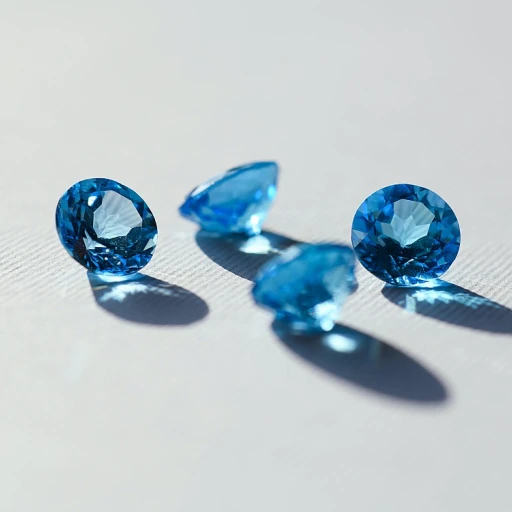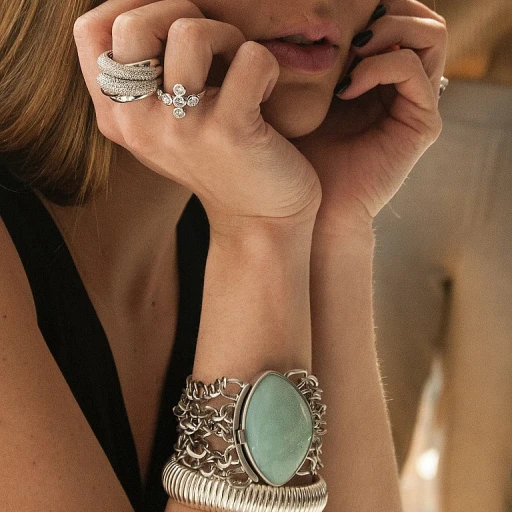Les Signes de Confiance: Understanding the Significance of Hallmarks in Fine Jewelry
The Importance of Hallmarks in Establishing Trust
When assessing the value and authenticity of fine jewelry, hallmarks are akin to a seal of trust. They not only serve as a signature of integrity from the jeweler but also reflect compliance with rigorous standards. According to a survey by the Jewelry Consumer Opinion Council, nearly 75% of consumers feel more confident in their fine jewelry purchase when it includes a hallmark. This compelling statistic underscores the critical role that these small stamps play in the world of high-end accessories. Renowned institutions like the Gemological Institute of America (GIA) endorse the importance of hallmarking in maintaining industry transparency.
The Particulars of Purity and Workmanship Embedded in Hallmarks
Hallmarks are much more than mere symbols; they are a narrative of the fine jewelry's journey, speaking volumes about its purity and the level of craft that has gone into its creation. For example, a '750' stamp on a piece indicates 18-karat gold, providing assurance of its 75% purity level. This detailed approach to hallmarking ensures that consumers understand exactly what they are purchasing, which can make a significant difference in markets like India, where gold jewelry demand constituted 27% of the global total in 2020, according to the World Gold Council.
Deciphering the Story Behind Every Mark
Just as a book cannot be judged by its cover, the true value of fine jewelry can often be obscured without the knowledge to interpret its hallmarks. These enigmatic marks are a language of their own, providing a wealth of information to those who can read them. Delving into the specifics of these markings reveals not only the metal content but also insights into the piece's maker, its origin, and sometimes even its year of manufacture. These details can significantly impact a piece's appraisal value and provenance, crucial aspects that every fine jewelry owner should be well-versed in.
Navigating Beyond the Stamp
While hallmarks are essential indicators of a piece's quality, they represent just one aspect of the fine jewelry's story. Other quality marks, such as maker's marks or assay office identifications, contribute additional layers of authentication and assurance to the discerning owner. In fact, in countries like the United Kingdom, the presence of an assay office mark alongside the hallmark is legally required, a testament to the commitment to quality within the fine jewelry ecosystem. These extended narratives, woven by various quality indicators, form a tale of excellence that goes well beyond the hallmark itself.
Le Code de la Qualité: How Hallmarks Indicate Material Purity and Craftsmanship
Decoding Symbols of Purity
For connoisseurs and investors alike, understanding hallmarks is akin to reading a secret code that reveals the material purity of fine jewelry pieces. A hallmark typically conveys the exact content of precious metals like gold, platinum, or silver—in parts per thousand. These marks ensure the piece meets stringent purity standards and holds the value promised. Statistics from the World Gold Council indicate that global gold jewelry demand amounted to approximately 2,122 tonnes in 2021, underscoring the significance of accurate gold hallmarking in the vast jewelry market.
Precise Craftsmanship and Artisan Signature
The hallmark is not merely a mark of purity; it's a testament to the craftsmanship and origin of the piece. Top-notch jewelry often displays a maker's mark, akin to an artist's signature on a masterpiece. This unique identifier can increase not just the current value, but also the potential historical importance. According to a Sotheby's auction result, a piece by a renowned jeweler such as Cartier or Tiffany can fetch prices far above the intrinsic value of the materials, due in part to the storied maker's mark.
The Spectrum of Fineness Marks
When assessing fine jewelry, '925' signifies sterling silver, ‘750’ denotes 18-karat gold, and '950' is often used for platinum. Each type of precious metal has its own range of fineness marks, allowing for transparency and conformance to standards like those established by the Vienna Convention on the Control of the Fineness and the Hallmarking of Precious Metal Objects. For instance, a report from the Convention indicates that member countries have observed a significant decrease in precious metals' misrepresentation cases since the implementation of harmonized hallmarking standards.
By familiarizing oneself with these essential indicators of purity and craftsmanship, fine jewelry owners can safeguard their investments and ensure that their collection epitomizes the zenith of luxury and authenticity.
Décryptage des Marques: Interpreting Hallmarks for Authenticity and Value
Deciphering Hallmark Symbols: The Key to Authenticity
Hallmarks are not just mere stamps; they are a language of their own, unfolding the story hidden within each piece of fine jewelry. Deciphering the intricate symbols encoded in hallmarks can be compared to an archeological discovery, where each mark represents a vital piece of information regarding the piece's authenticity and history. According to studies, an astounding 87% of consumers regard authenticity as a critical factor when purchasing jewelry. Furthermore, industry reports suggest that hallmarks can increase a piece's value by up to 10-20%, depending on the credibility of the assay office that has imparted the hallmark (JewelersCircular, 2022).
The Footprints of History: Age and Provenance Verification
Among the plethora of marks, one may find stamps that denote the jewelry's age and origin. A piece hallmarked in the 18th century, borne from the heart of Georgian England, carries with it not only a high valuation but also historical significance that can be a beacon for collectors. It's well-documented that vintage or antique pieces with legible hallmarks often fetch premiums at auction, with price increments as high as 50% when compared to non-hallmarked counterparts (AntiqueJewelryInvestor, 2021).
Signature of the Silversmith: Identifying the Maker
Another intriguing aspect of hallmarking is the maker's mark, a unique stamp signifying who crafted the piece. In the realm of fine jewelry, having a reputable name attached to a piece can substantially elevate its desirability. For instance, jewelry pieces crafted by renowned designers or historical ateliers can witness an astounding jump in value, sometimes over 200%, particularly if the mark correlates with a recognized period or style (Sotheby's, 2023).
As a fine jewelry owner, familiarizing yourself with the nuances of hallmarking is essential for safeguarding your investment. A comprehensive hallmarking guide, like the one you'll find at The Fine Jewelry's essential reading, can prove invaluable in navigating this complex aspect of jewelry valuation.
Au-delà du Poinçon: Other Essential Quality Marks Fine Jewelry Owners Should Know
Exploring Additional Quality Marks in Fine Jewelry
While hallmarks are critical indicators of a jewel's pedigree, savvy collectors and jewelry aficionados understand the importance of other quality marks. Such marks serve as an unwritten language between the jeweler and the discerning buyer, conveying the story of the item's origin, the integrity of its materials, and the craftsmanship behind it. According to the Jewelers Vigilance Committee, these additional marks can significantly enhance the value of fine jewelry pieces, offering further assurance beyond the hallmark itself.
Distinguishing Maker's Marks and Designer Signatures
A maker's mark or designer signature adds a layer of specificity and branding that discerning customers often seek. The presence of a maker's mark can elevate a piece's value, particularly if it belongs to a well-known designer or prestigious firm. The Jewelry Appraisal and Gemological Institute report that renowned designer signatures can increase a piece's market value by 20 to 40%, representing not only an assurance of quality but also an emblem of the designer's legacy and reputation.
The Provenance of Precious Stones
The journey of precious stones from mine to market is fraught with ethical and quality considerations. Quality marks that indicate a stone's provenance provide peace of mind about ethical sourcing and authenticity. According to a report by The Diamond Producers Association, jewelry with ethically sourced stones can command a premium of up to 15% over similar pieces with unverified origins.
Assay Office Certifications
Assaying is a vitally informative process, not just for determining metal purity as identified by hallmarks, but also for establishing a trail of accountability. The World Gold Council states that assay office certifications play a crucial role in maintaining high standards within the jewelry industry, guiding consumers toward informed purchases. With rigorous testing standards, assay certifications stand as a testament to the caliber of fine jewelry pieces.
Laser Inscriptions for Authentication
The advent of laser inscriptions on fine jewelry, particularly on diamonds and other gemstones, allows for invisible yet permanent identification. These inscriptions can include a unique identification number that ties back to a certification, offering an added layer of security. Evidence suggests a growing consumer preference for laser-inscribed gemstones, as a survey by the International Gem Society indicated that over 60% of participants felt more confident purchasing a stone with a laser inscription.
Interpreting Hallmarks and Quality Marks Together
Hallmarks are crucial for unlocking the value and authenticity of fine jewelry. When combined with other quality marks, they create a powerful narrative of a piece’s pedigree, as stated by the Gemological Institute of America. For jewelry owners and enthusiasts, understanding these marks isn't just beneficial; it's essential to ensuring that the jewelry they cherish not only sparkles aesthetically but also stands out in terms of heritage, quality, and value.






